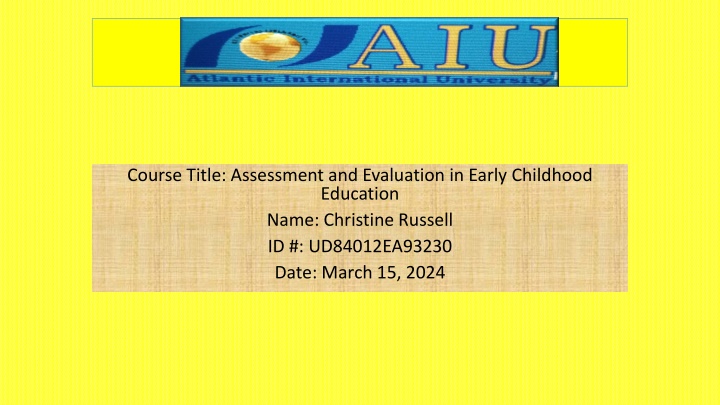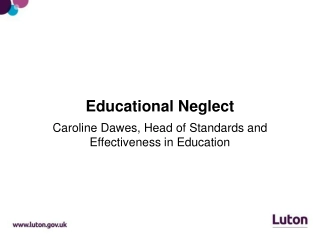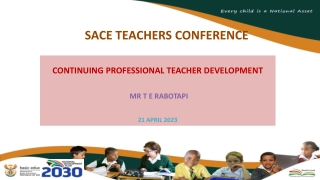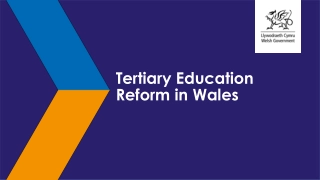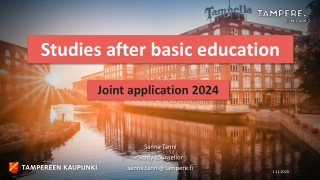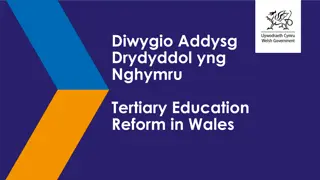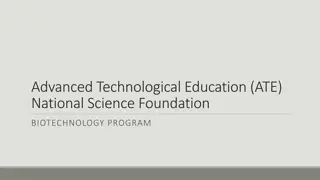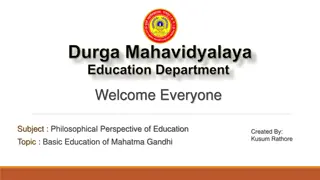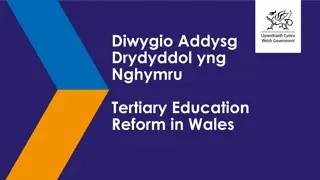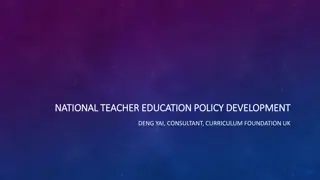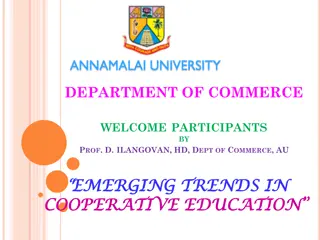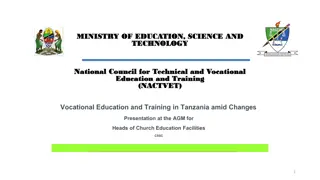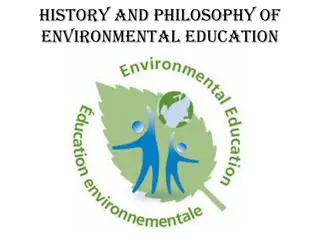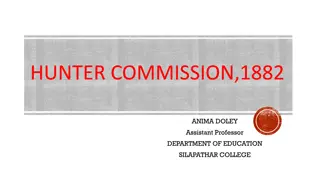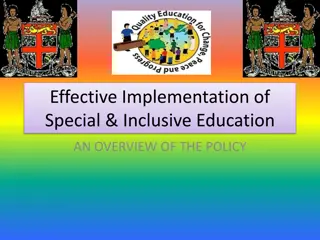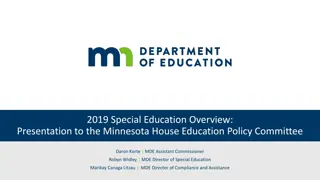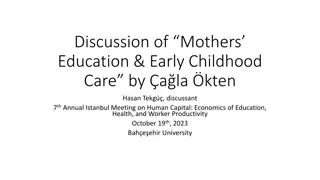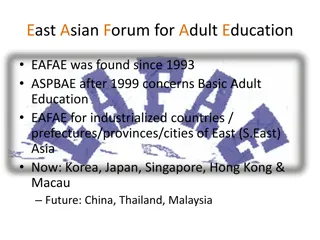Education
The importance of formative assessment in early childhood education, with a focus on effective implementation approaches based on current educational ideas. Examples include observational assessments to track children's developmental progress and engagement levels.
Download Presentation

Please find below an Image/Link to download the presentation.
The content on the website is provided AS IS for your information and personal use only. It may not be sold, licensed, or shared on other websites without obtaining consent from the author.If you encounter any issues during the download, it is possible that the publisher has removed the file from their server.
You are allowed to download the files provided on this website for personal or commercial use, subject to the condition that they are used lawfully. All files are the property of their respective owners.
The content on the website is provided AS IS for your information and personal use only. It may not be sold, licensed, or shared on other websites without obtaining consent from the author.
E N D
Presentation Transcript
Course Title: Assessment and Evaluation in Early Childhood Education Name: Christine Russell ID #: UD84012EA93230 Date: March 15, 2024
Introduction Introduction In the US, Bowman, Donovan, and Burns (2001) suggest that the term assessment, as applied in early childhood education, generally implies the intention to provide a rich picture of the ways in which young children act, think and learn. In the UK, Hurst and Lally (1992) describe how assessment involves educators in documenting, analyzing and reflecting on the information collected, and using this to plan and support further learning. When the educator makes judgements about promoting children s learning based on the information gleaned through observation and interaction with them, then the assessment is considered to be formative, i.e., it promotes learning (see Gipps 1994; Torrance 2001).
A recent large-scale longitudinal study of early learning settings in England confirmed the importance of formative assessment in meeting children s needs and in supporting their learning (SirajBlatchford et al. 2002). It is argued that assessment must work for young children: We can use our assessments to shape and enrich our curriculum, our interactions, our provision as a whole: we can use our assessments as a way of identifying what children will be able to learn next, so that we can support and extend that learning. Assessment is part of our daily practice in striving for quality. (Drummond 1993, 13)
Thus the focus of this paper is on identifying and promoting approaches to formative assessment which are based on current ideas about early learning and which are coherent with open framework curricula. Approaches identified are those that can be used by educators of children aged birth to six years, as appropriate, in the range of educational settings.
Question 1: Question 1: Define formative assessment in the context of early childhood Define formative assessment in the context of early childhood education and provide two examples of how it can be implemented effectively. education and provide two examples of how it can be implemented effectively. Observational Assessments: Teachers can conduct regular observations of children during various activities, such as playtime, group activities, or individual tasks. By carefully observing children's interactions, behaviors, and engagement levels, teachers can gather valuable information about their developmental progress, interests, strengths, and areas for improvement. For example, a teacher might observe how a child interacts with peers during a collaborative art project to assess their social skills, communication abilities, and creativity.
The understanding of young childrens relationships with each other is also key in recognizing and assessing early learning. For instance, young children (aged 14- to 30-months) have been seen to develop communication with other children, and vary their imitations of other children s behaviors, thus demonstrating collaboration and agency (Lindahl and Pramling Samuelsson 2002). The desire to develop a new means of assessing the cognitive abilities of pre-school children provided the impetus for Project Spectrum, a research and development project based on the theories of Gardner (1993) and Feldman (1994).
Assessing cognitive abilities: Both theories emphasize a broader view of human cognition than that offered by previous theories. Krechevsky describes how Gardner s theory emphasises a wide range of intelligences which had not been not previously identified or documented in assessing early learning, while Feldman articulated a theory of universal and non-universal domains of development. During the course of the project, curriculum and assessment materials were devised, and these tapped a wider range of cognitive and stylistic strengths than typically had been addressed in early childhood programmes (Krechevsky 1998, 1). Gardner (1999) describes how children are surveyed in a variety of intellectual domains (movement, language, mathematics, science, social, visual art and music).
Specific tasks and measures that are engaging to children, for example mathematical games in the case of mathematics, are introduced in the course of natural classroom activity and children are assessed using these. Observations of children in potentially challenging situations that arise in the ordinary course of events (for example, an argument with another child) are also regarded as appropriate in assessing certain areas of development.
Anecdotal records: Teachers can keep anecdotal records of significant moments or behaviors observed during the day. These records can include brief descriptions of a child s action, interactions and achievements, along with the date and the context of the observation. anecdotal records provides a rich source of qualitative data that can help teachers track individual progress, identifying patterns or trends over time, and tailor instruction to meet each child s needs. For example, a teacher might jot down notes about a child s problem solving approach during block play or their use of vocabulary during story-time to assess their cognitive and language development.
Summary Summary Formative assessment in early childhood education refers to the ongoing process of gathering information about a child's learning progress and development in order to inform instructional decisions and provide feedback for improvement. Unlike summative assessment, which typically occurs at the end of a learning period to evaluate what a child has learned, formative assessment happens throughout the learning process. Overall, formative assessment in early childhood education relies on a combination of observation, documentation, and ongoing reflection to support children's learning and growth in a developmentally appropriate manner.
Conclusion Conclusion In concluding, assessment in early childhood is about making the range of children s early learning visible. This can be achieved through the processes of collecting information about children s learning, documenting that information, reflecting on it and then using the information to support and extend learning. We have also seen contributions of several theories in the development of suitably rich accounts of children s early learning. The narrative approach is one that offers educators a way of providing a rich picture of early learning through documenting particular instances of learning; reflecting on learning, communication and making informed decisions about children s learning.
Bibliography Bibliography Bowman, B., S. Donovan, and S. Burns. 2001. Eager to learn: Educating our pre-schoolers. Report of Committee on Early Childhood Pedagogy, Commission on Behavioral and Social Sciences and Education National Research Council. Washington, DC: National Academy Press. Hurst, V., and M. Lally. 1992. Assessment and the nursery curriculum. In Assessment in early childhood education, ed. G. Blenkin and A. Kelly, 46-68. London: Paul Chapman Publishing. Gipps, C. 1994. Beyond testing: Towards a theory of educational assessment. London: Falmer Press. Torrance, H. 2001. Assessment for learning: Developing formative assessment in the classroom, Education 3-13 October: 26-32.
Siraj-Blatchford, I., K. Sylva, S. Muttock, R. Gilden, and D. Bell. 2002. Researching effective pedagogy in the early years (REPEY): DFES (Department for Education and Skills) research report 356. London: DFES, HMSO. Drummond, M.-J. 1993. Assessing children s learning. London: David Fulton Publishers. Lindahl, M., and I. Pramling Samuelsson. 2002. Imitation and variation: Reflections on toddlers strategies for learning. Scandinavian Journal of Educational Research 46, no. 1: 25-45 Gardner, H. 1993. Multiple intelligences: The theory in practice. New York: Basic Books.
Krechevsky, M. 1998. Project spectrum: Pre-school assessment handbook. New York: Teachers College Press. Feldman, D. 1994. Beyond universals in cognitive development. Westport, CN: Ablex Publishing Gardner, H. 1999. Assessment in context. In Learners, learning and assessment, ed. P. Murphy, 90-117. London: Open University
Question 2: Question 2: Discuss understanding and supporting the development of young children. Provide an understanding and supporting the development of young children. Provide an example of a situation where observational assessment would be particularly example of a situation where observational assessment would be particularly beneficial. beneficial. Discuss the importance of observational assessment methods in the importance of observational assessment methods in Observational assessment methods play a crucial role in understanding and supporting the development of young children for several reasons: Holistic Understanding: Observing children in their natural environments allows educators and caregivers to gain a holistic understanding of their development. This includes not only cognitive development but also social, emotional, and physical aspects.
Individualized Support: Every child is unique, and observational assessments enable educators to tailor their support and interventions according to the specific needs and strengths of each child. By observing their behaviors, interactions, and responses to various stimuli, educators can identify areas where children may need additional support or enrichment Early Intervention: Observational assessments help in early identification of developmental delays or challenges. Early intervention is crucial in addressing these issues promptly, which can significantly improve outcomes for children in the long term.
Authentic Assessment: Observing children in natural settings provides authentic and contextually relevant data. It allows educators to assess children's skills and abilities in real-life situations, rather than relying solely on standardized tests or assessments that may not capture the full range of a child's capabilities. Relationship Building: Observation provides opportunities for educators to build strong relationships with children and their families. By spending time observing and interacting with children, educators can gain insights into their interests, preferences, and unique personalities, fostering a sense of trust and rapport.
Example Situation: Imagine a preschool classroom where a teacher notices that a child, let's call him Alex, is consistently avoiding social interactions during group activities. He often sits alone and seems hesitant to engage with peers or participate in discussions. Through careful observation, the teacher notices that Alex shows a keen interest in building structures with blocks during free playtime. In this situation, observational assessment would be particularly beneficial in several ways: Identifying Social-Emotional Needs: The observation helps the teacher recognize that Alex may be experiencing social-emotional challenges, such as shyness or anxiety in group settings Understanding Strengths: The observation also highlights Alex's strength and interest in building activities, which can serve as a potential avenue for engagement and learning.
Tailoring Support: Armed with this information, the teacher can design activities that capitalize on Alex's interest in building while gradually scaffolding opportunities for social interaction. For example, the teacher might introduce collaborative building projects where Alex can work with a small group of peers, providing a supportive environment for him to engage sociallywhile pursuing his interest Initiating Dialogue with Parents: Observations like these can also prompt conversations with Alex's parents about his social-emotional development and strategies for supporting him both at school and at home.
Summary Summary In summary, observational assessment methods offer valuable insights into the development of young children, allowing educators and caregivers to provide individualized support, identify areas of strength and need, and promote positive outcomes for each child.
Conclusion Conclusion In concluding, observation has long been recognized as key to uncovering children s learning, the meaning of their actions, their mark-making and their words. Drummond (2000) describes how Issacs put her observational data related to what children did, thought and felt to excellent use in drawing it together to construct a coherent account of the development of children s intellectual and emotional powers. Issacs wrote narrative accounts, and this approach continues to be developed and refined in the modern context.
Bibliography Bibliography Drummond, M.-J. 2000. Comparisons in early years education: History, fact and fiction. Early Childhood Research and Practice 2, no. 1. http://ecrp.uiuc.edu/v2n1/drummond.html
Question 3: Compare and contrast norm-referenced and criterion-referenced assessments in the context of early childhood education. Provide examples of each type of assessment and explain their respective advantages and limitations. Norm-referenced and criterion-referenced assessments are two common types of assessments used in early childhood education. Here's a comparison of both: Norm-Referenced Assessments: Definition: Norm-referenced assessments compare an individual child's performance to that of a larger group (or norm group) of children of the same age or grade level. The goal is to rank students and identify where they fall within the normative distribution. Example: The standardized IQ test is a classic example of a norm-referenced assessment. In early childhood education, norm-referenced assessments might include standardized tests in areas like reading readiness, mathematics, or language development.
Advantages: Provide a comparative measure, allowing educators to see how a child's performance compares to that of their peers. Help identify strengths and weaknesses relative to the norm group. Limitations: May not provide information on specific skills or areas of weakness. Can create pressure to perform at or above the average, potentially leading to stress or anxiety in children
Norm-Referenced Assessment: Norm-referenced assessment compares an individual's performance against the performance of a group. The focus is on ranking students rather than measuring mastery of specific skills or knowledge. Some theorists argue in favor of norm-referenced assessments in early childhood education for the following reasons: Differentiation: Glaser, R. (1963). Argues that norm-referenced assessments allow for differentiation among students, providing a clear understanding of where each child stands in comparison to their peers. Identification of Special Needs: Good, R. H., & Jefferson, G. (1998). suggest that norm-referenced assessments can help identify students who may require additional support or who may be advanced and in need of enrichment. Standardization: They emphasize the standardized nature of norm-referenced assessments, which they believe provides a fair and objective way to evaluate students across diverse backgrounds.
Criterion-Referenced Assessments: Definition: Criterion-referenced assessments measure a child's performance against a specific set of criteria or standards. The goal is to determine whether a child has mastered certain skills or concepts. Example: An example of a criterion-referenced assessment in early childhood education could be a checklist or rubric used to assess a child's ability to recognize letters of the alphabet or count to a certain number. Advantages: Focus on specific learning objectives or standards, providing detailed information on a child's mastery of skills. Can be tailored to the individual child's developmental level and needs. Limitations: May not provide information on how a child's performance compares to that of their peers. Requires clear and well-defined criteria, which can be challenging to develop and apply consistently.
Criterion-Referenced Assessment: Criterion-referenced assessment focuses on whether a student has achieved specific learning objectives or criteria. It's about assessing mastery rather than comparing performance to peers. Theorists supporting criterion-referenced assessment in early childhood education argue for the following: Focus on Mastery: McMiIlan, J. H., Myran, S., & Workman, D. (2002). emphasized that criterion-referenced assessments prioritize mastery of skills and knowledge, ensuring that all students are held to the same standards regardless of how their peers perform. Informing Instruction: Popham, W. J. (1979). argued that criterion-referenced assessments provide more useful information for teachers to inform their instruction, as it highlights specific areas where students may need additional support or challenge.
Developmentally Appropriate: Advocates suggest that criterion-referenced assessments can be more developmentally appropriate for young children, as they focus on individual growth rather than competition.
Summary Summary In summary, norm-referenced assessments compare a child's performance to that of their peers, while criterion-referenced assessments measure a child's performance against specific standards or criteria. Both types of assessments have their advantages and limitations, and educators often use a combination of both to gain a comprehensive understanding of a child's development and learning progress. Norm-referenced assessment and criterion-referenced assessment are both commonly used in early childhood education, each with its own proponents and critics amongtheorists.
Conclusion Conclusion In concluding, both types of assessments have their place in early childhood education, and many educators use a combination of both to get a comprehensive understanding of student s abilities and needs. It s essential to consider the context, purpose, and developmental appropriateness of each assessment practices in early childhood education.
Bibliography Bibliography Glaser, R. (1963). Instructional technology and the measurement of learning outcomes: Some questions. American Psychologist, 18(8), 519 521. Good, R. H., & Jefferson, G. (1998). The role of assessment in instruction for young children: Purposes, benefits, and challenges. Journal of Psychoeducational Assessment, 16(4), 325 344. McMillan, J. H., Myran, S., & Workman, D. (2002). Elementary teachers' classroom assessment and grading practices. Journal of Educational Research, 95(4), 203 213. Popham, W. J. (1979). Myths and realities about criterion-referenced tests. Educational Leadership, 36(3), 195 199.
Question 4: Explain the concept of authentic assessment in early childhood education. Describe two strategies for designing authentic assessments that align with the developmental needs and abilities of young children. Authentic assessment in early childhood education focuses on evaluating children's learning and development through real-life contexts and activities that are meaningful and relevant to their experiences. Unlike traditional assessments that rely heavily on standardized tests and abstract tasks, authentic assessment aims to capture a more holistic view of children's abilities, including their social, emotional, cognitive, and physical skills.
Here are two strategies for designing authentic assessments that align with the developmental needs and abilities of young children: 1. Observation-Based Assessments: Observation-based assessments involve systematically observing children as they engage in various activities and interactions within their natural environments, such as classrooms, playgrounds, or homes. Educators can create structured observation protocols that focus on specific developmental domains, such as language development, social skills, problem-solving abilities, and fine or gross motor skills. To ensure authenticity, observations should be conducted over time and in different contexts to capture a comprehensive understanding of each child's strengths, challenges, interests, and progress.
Lilian G. Katz: Katz is renowned for her work on early childhood education and developmentally appropriate practice. She emphasizes the importance of authentic assessment methods that align with the principles of child development and curriculum goals. Her work often highlights the need for observational assessments and documentation of children's learning experiences. Assessment tools such as checklists, anecdotal records, or running records can be utilized to document observations and track children's development effectively. Teachers can also involve children in the assessment process by encouraging self- reflection and self-assessment, fostering their sense of agency and ownership over their learning journey. David Elkind: Elkind is known for his research on cognitive and emotional development in children. He emphasizes the importance of assessing children's understanding and abilities within meaningful contexts that reflect their daily experiences and interests.
2. Project-Based Assessments: Project-based assessments center around collaborative, hands-on projects that allow children to explore topics of interest in-depth, solve real-world problems, and demonstrate their knowledge and skills in meaningful ways. Teachers can facilitate the design of open-ended projects that incorporate interdisciplinary learning experiences, such as science experiments, art projects, community investigations, or dramatic play scenarios. Jerome Bruner: Bruner's theories on constructivism and scaffolding have influenced the approach to authentic assessment by highlighting the importance of understanding children's learning processes and providing support as they engage in meaningful activities.
Throughout the project, educators can gather evidence of children's learning through various means, including observations, conversations, work samples, multimedia artifacts, and reflective journals. Assessment criteria should be clearly communicated to children, emphasizing not only the final product but also the process of inquiry, collaboration, creativity, and critical thinking. By engaging in project-based assessments, children have the opportunity to showcase their unique strengths and abilities while developing essential skills such as communication, collaboration, problem-solving, and resilience. Howard Gardner: Gardner's theory of multiple intelligences suggests that children possess different types of intelligence, which should be recognized and assessed through varied and authentic means that reflect their diverse strengths and abilities.
Summary Summary In summary, authentic assessment in early childhood education involves evaluating children's learning and development through real-life contexts and activities that are relevant to their experiences. Observation-based assessments and project-based assessments are two effective strategies for designing authentic assessments that align with the developmental needs and abilities of young children, fostering a comprehensive understanding of their progress and achievements.
Conclusion Conclusion In concluding, Authentic assessment in early childhood education is a concept that emphasizes the evaluation of children's learning in real-life contexts, focusing on their skills, knowledge, and abilities as they naturally occur and develop. Theorists in the field of early childhood education have contributed various perspectives and insights on authentic assessment, highlighting its importance in promoting meaningful learning experiences for young children.
Bibliography Bibliography Katz, L. G., & Chard, S. C. (2000). Engaging children's minds: The project approach. Greenwood Publishing Group. Katz, L. G. (2008). Talks with teachers of young children: A collection. Routledge. Elkind, D. (2007). The power of play: Learning what comes naturally. Da Capo Press. Bruner, J. S. (1966). Toward a theory of instruction. Harvard University Press. Bruner, J. S. (1986). Actual minds, possible worlds. Harvard University Press. Gardner, H. (1993). Frames of mind: The theory of multiple intelligences. Basic Books.
Question 5: Analyze the role of standardized testing in early childhood education. Discuss potential implications for curriculum planning and instruction, as well as strategies for mitigating any negative effects on young learners. Standardized testing in early childhood education has been a topic of considerable debate, with proponents arguing for its ability to measure student progress and ensure accountability, while critics raise concerns about its appropriateness for young learners and its potential to narrow the curriculum and increase stress on students. Let's analyze the role of standardized testing in early childhood education and its implications for curriculum planning and instruction, as well as strategies for mitigating any negative effects on young learners:
1. Role of Standardized Testing: Meisels, S. J. (Ed.). (2013). Standardized testing in early childhood education is often used to assess students' academic skills and abilities in areas such as literacy, numeracy, and cognitive development. It provides data that can inform educators, parents, and policymakers about student progress and school performance. Standardized test results may influence decisions related to curriculum planning, resource allocation, and educational policies.
2. Implications for Curriculum Planning and Instruction: Standardized testing can lead to a "teaching to the test" approach where educators focus primarily on content and skills that are likely to be assessed, potentially neglecting other important aspects of early childhood development such as social- emotional skills, creativity, and critical thinking. Copple, C., & Bredekamp, S. (2009. Narrowing the curriculum to focus on tested subjects may limit opportunities for exploration and play-based learning, which are essential for young children's holistic development. High-stakes testing may increase pressure on teachers, students, and schools, leading to a stressful learning environment that is not conducive to optimal learning outcomes.
3. Strategies for Mitigating Negative Effects: Emphasize holistic assessment: Supplement standardized testing with a variety of assessment methods, including observations, portfolios, and performance-based assessments, to provide a more comprehensive understanding of children's abilities and progress. Foster a balanced curriculum: Ensure that curriculum planning includes a wide range of experiences and activities that address the cognitive, social, emotional, and physical development of young learners. Provide professional development: Sylva, K., Melhuish, E., Sammons, P., Siraj- Blatchford, I., & Taggart, B. (2010). Offer training and support for educators to help them design developmentally appropriate instruction that meets the diverse needs of young children while aligning with curriculum standards.
Advocate for policy change: Work with policymakers and educational stakeholders to advocate for assessment policies that prioritize meaningful learning experiences and minimize the negative impact of standardized testing on young children.
Summary Summary Standardized testing in early childhood education can play a role in assessing student progress and informing educational practices, but it also poses challenges related to curriculum planning, instruction, and the well-being of young learners. By implementing strategies such as holistic assessment, balanced curriculum planning, professional development for educators, and advocacy for policy change, stakeholders can work to mitigate the negative effects of standardized testing and promote the holistic development of young children.
Conclusion Conclusion In concluding, standardized testing in early childhood education is a topic of debate among theorists and educators. While some argue that it provides valuable insights into children's academic progress and can inform instruction, others raise concerns about its potential negative implications for curriculum planning, instruction, and young children's development. Critics argue that standardized testing may lead to a narrowing of the curriculum, as teachers may feel pressured to focus solely on tested subjects at the expense of other important areas such as social-emotional development, creativity, and critical thinking skills. Additionally, young children may experience stress and anxiety from testing situations, which can be detrimental to their overall well-being and motivation to learn.
